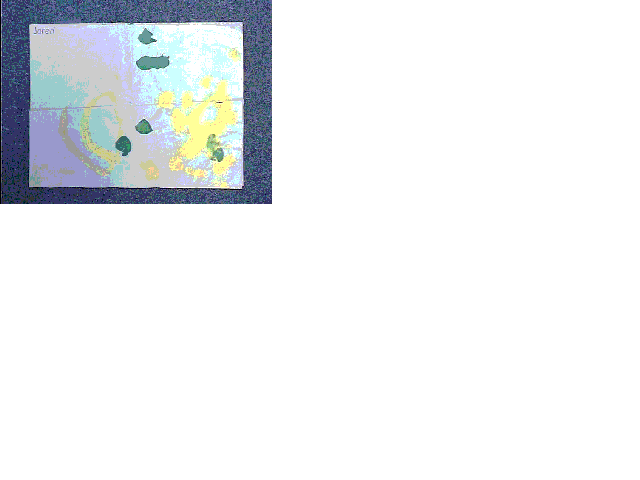 2.
2. 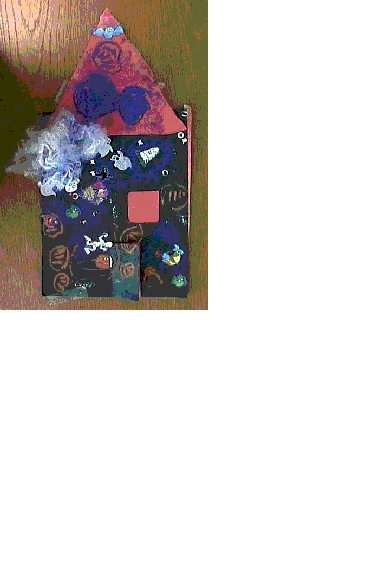 3.
3. 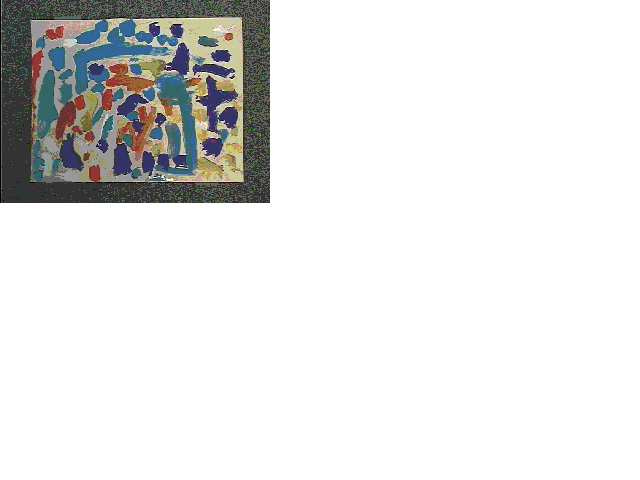
Profit v. Peril
Linda McKay
Writing Workshop II
Dr. Julia Keefer
November 21, 1998
There can be no greater demonstration of the human drive to express repressed emotion creatively than the children's art exhibit in the Prague, Czechoslovakia Jewish Museum. With the most meager materials available: cardboard, string, rocks and char dust, children in the 1943 Jewish concentration camp, Terezin, expressed in images how they felt to exist in environs where emotional repression insured invisibility (McKay, 1990) (Silverstone, 1997). Fifty-five years later, journal and art therapy are current leading psychotherapy treatments for emotionally-repressed adolescent patients suffering memory block or verbal impotence. These victims protectively cradle secrets resulting in delinquent behavior, suicide attempts and eating disorders. The two therapies permit patients to relinquish control and decimate roadblocks to recovery, as they release their minds' locked closets to permit the offending skeletons' examination. While guiding patients through their skeletal discoveries, art therapists assume a passive role permitting the patients' solo interpretations of their literary or artistic symbolisms (Silverstone).
Unfortunately, America's legal system threatens these two vital therapies, for if an adolescent is suspected of intent to commit, or is involved in a delinquent crime, whether plaintiff or defendant, these creative endeavors may be discoverable and admissible evidence in Court. A Motion to Compel which demonstrates compelling need for discovery, (definition of "compelling need": "information which cannot be obtained elsewhere") of an adolescent's journals and art therapy documents may satisfy the legal requirement in subpoenaing this evidence for second party evaluation. Since the success of journal and art psychotherapy in the art therapist's 1998 domain relies on the delinquent adolescents' (ages ten to seventeen) willingness to express non-judged emotion (Cameron 1992), these creative endeavors should be barred as valid evidence to be judged by American Court second parties, or these discovery parameters will threaten the therapy's future, and American society's future in coping with repressed adolescents sans a successful treatment.
Right Brain Repression
The compelling need is the urgency for art therapy in western culture. When both hemispheres of the brain are functioning in tandem, a human is operating at ideal competence. Journal and art therapies' stunning accomplishments are made possible by guiding the patient through the synchronization of both hemispheres facilitating the patient's right and left brains locking together like a perfect puzzle permitting neural bridging from side to side. This is a process which does not come naturally to these patients, since western civilization honors the left side of the brain and often neglects the right hemisphere. The message rendered regarding right-brained achievement is that it is non-academic and a sure invitation for economic-earning doom (Cameron, 1992). Although children are born creative beings, as demonstrated by their ability to artistically fantasize and fortify storytelling skills, western culture represses acknowledgment of their brain's right hemisphere and disavows their spontaneous, intuitive cognition. Rather, rational and logical thinking proven by empirical knowledge, is the cornerstone of the child's public school evaluation in his educational endeavors (Silverstone, 1997).
1.  2.
2.  3.
3. 
4. 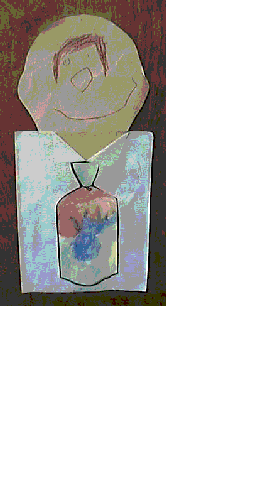 5.
5. 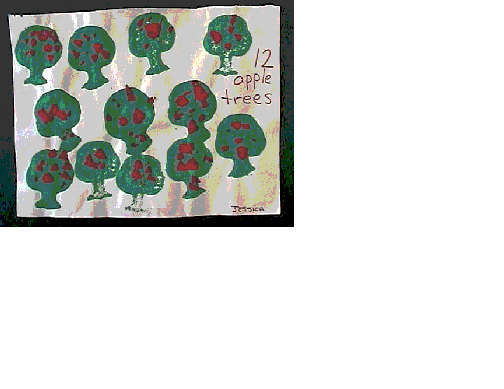
Figures 1-5 display selected children's artwork from ages 2.5 through 4.5. In figure 1, the 2.5 year old's free art form consists of simple circular strokes with 2 colors: yellow and green; figure 2 is a 3.0 year old's free form displaying more complex design with five colors: purple, yellow, orange, white and aqua; figure 3 is a 4.0 year old's creation which shows the introduction of a linear progression. The child was provided a square, triangle, rectangle, decorative stickers and cotton, and prompted to place the geometric figures and decorations; figure 4 is a similar assignment with the introduction of a circle for a man's head; figure 5 is an absolute linear product prepared by a pre-kindergarten 4.5 year old. (Bennett, Mariano). Although motivating the child's left brain progression is educationally sound, similar incentive must be provided for the child to maintain optimum right brain circuitry. Even as parents, we render more appreciation and applause for the academically designed linear activities. Usually, these are the products which are proudly displayed on the family refrigerators or mailed to grandparents. As familial and school applause tips the scales toward the linear, the child will likewise tip his or her preference toward those projects.
Right brained cultural acknowledgment and repression owns a long history. Civilizations, such as the Mayans, taught their children that both hemispheres of the brain should be honored. Mayan children were instructed in identifying their mothers as "Rainbow Mother" or "Nurturing Mother." The Rainbow Mother was one who inspired her children with creative endeavors, while Nurturing Mother cared for her children and managed the family's day to day activity. Offspring were taught to identify their inheritance especially when choosing a spouse. "Two rainbow spouses may overlook paying their bills; or forget to eat, and they may starve to death lost in their own chaos. If a rainbow partner is deeply committed to work, and she finds a nurturing partner to look after her, then the marriage is superior" (Anderson, 1985, p. 77). Thus, the description of a perfect Mayan union was one combining creative expression with rational thinking.
Conversely, present-day western culture shares celebrated company in repressing right-brained activity. In 400 BC, Plato described representative art as "the inferior child of inferior parents." He likened art to using the "lowest part of the brain" because it does not deal with the brain's rational reasoning center, the left hemisphere (Lee, 1987, p. 373). Fifteen hundred years later, this repression re-germinated in the patriarchal Judeo-Christian religions. From 600 to 1100 AD, right brained wisdom was honored, particularly in the European civilization, when healers and priestesses developed their intuition and ability to advise their patients. As their ability to intuit and heal flourished, their power became a focus of Church leader jealousy, as well as those within their own civilization. (Silverstone, 1997). Right-brained activity was threatened and abolished by witchcraft accusations, trials and executions from 1100 to 1600 AD (Gregg, 1997).
Western civilization literature also contains elements of this repression. Aldous Huxley's fictional Brave New World civilization, squashed creative manifestation. In this perfect society, there was no freedom of artistic expression. "That's the price we have to pay for stability. You've got to choose between happiness and what people used to call high art. We've sacrificed the high art" (Huxley, 1932, p. 220). On the other hand, to repress the civilization's unhappy unsettling emotions, there was widespread frequent use of the drug soma (Huxley, 1932), which underscores current art therapy theory that synchronization of the brain's two hemispheres creates a healthy whole person. Societies which sacrifice this synchronization similarly forfeit the well-mindedness of the community's individuals. Although the American Psychological Association has recognized and embraced the importance of this proven principle in its support of art therapy, current U.S. law has built the sacrificial pyre for its participants. Therapists ask for patient trust with one hand extended, while advising the patient that disrobing his psyche and displaying honest emotion may cause him to be led away by the same trusted hand. How long before the treatment is abandoned?
Therapy Rewards
Anthropologists subscribe that stigma sounds a powerful death knell for cultural practice (Kulick, 1991). Western social stigma attached to the brain's right hemispheric powers has perpetrated right brain atrophy and shrinking like a stale raisin permitting repressed memories and emotions to hide in its nooks. Journal and art therapists must be permitted to coax this atrophied body part back to health with creative mental gymnastics until the adolescent's repressed anger can be expressed and interpreted by the patient without fear of recrimination. Anger is meant to be acknowledged. Its adolescent repression leads to oppositional behavior, chronic truancy, delinquent acting out, aggressive violent behavior, and chronic depression resulting in suicidal gestures including the eating disorders, anorexia and bulimia. While children were raised in the "Age of Anxiety" in the nineteen fifties and sixties with fear of nuclear war, children in the 1990s are being raised in the "Age of Anger". As we close out a century that has brought radical social change, we find adults and children coping with perceived injustices giving rise to insidious resentful thoughts and actions (Child/Adolescent [On-Line]). Conflict management workshops, abusive spouse workshops, verbal abuse management, fund-raising events to combat battered women abuse--the self-help lists grow along with society's burdens. The positive side of anger is that "it is an invitation to explore, and the map which points the way" (Cameron, 1992, p. 61). Creative therapy uncovers the fury, communicates to the adolescent that it is safe to illuminate the offending thought, and permits the interpreter to translate the message that the anger is sending (Cameron). The roadblock causing depression or "dis-ease" is torn down and new mentally healthy pathways are rebuilt. The most extensive trial of the therapies' proven success has been demonstrated with incarcerated prisoners. Anger is ever-present in the American penal system. Within the last five years, prisons have instituted journal and art therapy for inmate rehabilitation purposes. Weekly therapy sessions are held with the specialized therapists two years prior to the prisoner's parole date. Some prisons offer the treatment to all inmates, but with limited therapist resources, most of the institutions preserve the opportunity for those prisoners being released back into society. Data is being assembled, but not yet available, which will detail the success rate of the parolees which underwent these two therapies compared to those released who did not. Therapists report that inmate behavior during incarceration does improve with remarked decrease in reported incidents after three months of therapy, and angry outbursts subside dramatically (Ceci, 1998) . The two poems below were authored by inmates during their therapy.
Penance
As I sit and think of my future, my past,
what I have accomplished, what will last?
It seems my addiction has taken over my life.
Filling each day with pain and strife...
Groups...Meetings...One on Ones.
So much work to undue things I've done.
Can I make the changes needed for me to
stop this cycle, to make me free?
Bars On My Windows
I have bars on my window
and locks on my door.
My bed is just cold steel,
my back is always sore.
Time goes by so slowly
it creeps and it crawls
my life appears stagnant
I am stopped by large walls.
I'm caged like a lion,
I turn and pace.
The pain in my eyes
describes my disgrace.
Both poems speak of the authors' remorse for their committed crimes. The therapy has offered the offenders the opportunity to articulate their guilt and fears (Prisoner Art and Literature [On-Line]).
6. 
A case study sustaining this data reveals a female, aged 24, who credits adolescent art therapy for stemming her suicidal threats. At age 14 she began exhibiting oppositional behavior: cutting classes, defying curfew and defying family and school rules. Her family entered her into traditional therapy where she met weekly with an adolescent psychologist. Unable to verbalize her anger, the oppositional behavior persisted and developed into severe depression. Throughout the next two years, she experienced two hospitalizations for depression and suicidal thoughts. Her depression was manifested by a lack of desire to eat with weight loss, sleeplessness, and a loss of desire to live. Following the second hospitalization, she was admitted to an out-patient psychotherapy program which she attended daily after school hours. During this program, she was admitted to an art therapy program where she was able to "break through" her anger resistance and explore her suicidal tendencies. The drawing on figure 6 depicts her family members engaging during an unusually distressing time of the day. The depressed patient drew three members of her family when indeed there were four. When questioned by the art therapist as to the missing member, she replied, "My father's not in the picture. He's never in the picture." When asked by the art therapist to interpret her statement, she answered, "He doesn't care about me. He doesn't love me." That statement was the first verbalization of her perception of her role in her father's life. Her depression subsided, and the family engaged in therapy to help her cope with this perception. The patient remained in therapy for approximately two years further; and reports that although her relationship with her father is far from model, she has cleared the hurdle of feeling inadequate and accepted his inadequacy in fully engaging in a father/daughter alliance (K.V.).
As further evidence of the treatment's value, a Journal and Art Therapy Workshop was conducted by this author, the student therapist, on November 14, 1998 at New York University in Dr. Julia Keefer's Writing Workshop II class (McKay Workshop). One of the ground rules declared for the therapy session was complete confidentiality of all discussions and no further conversation permitted outside the classroom. Students were led through three exercises: (Appendix A).
The first was a stream of consciousness writing designed to clear excess thought which could be blocking access to creativity. The students were asked to utilize their notebooks in journal fashion for five minutes, where they "dumped" unedited thoughts from head to paper. They were assured that these writings were for their eyes only and not to be shared with the class.
The second was a free association exercise aimed at clearing anger stemming from criticism of their work, and students were advised that these responses could be shared if they wished.
The third was an art therapy exercise fashioned to help students connect with "inner wisdom" and to trust those flashes of creativity. Students were advised that they would be asked to interpret their individual creations.
7. 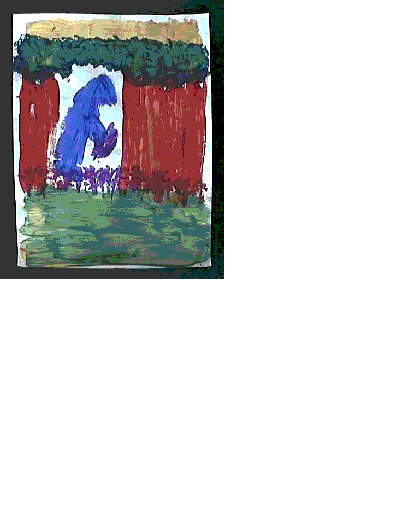
Students actively engaged in each exercise, willingly sharing their free association responses from Exercise 2; and all participants displayed their artwork and interpreted their responses from Exercise 3. Some responses were emotional, some insightful and others revealed current circumstances. Students actively engaged along with the student therapist in assisting interpretations and offering advice to each other. One of the student's art therapy creations shown in Figure 7 was interpreted after a guided imagery to a "wise old person" who offered a gift. The student volunteered that her drawing depicted that she did not like her gift and was very disappointed. The student therapist asked the student if she is often disappointed when examining her creative concepts for projects. The student admitted that she is. "I get this great idea and then I tear it to shreds and never use it (Workshop Participant)." Participants agreed that there was a general feeling of well being and excitement when the session was concluded. Some offered that this type of class would be helpful at a University level. The student therapist was thanked privately when the class period ended by at least three participants for the value manifested by the therapy.
From penal institutions, to high schools, to one of the most highly respected University's in the world, these cases corroborate that Americans exist on self-demanding treadmills in an angry society. With biology contributing generously to their passion, adolescents feel this anger most keenly. To the remainder of their society, their anger makes them the most unlovable during the time that they need to be loved the most. Journal/Art Therapy is the wizardry which converts adolescent anger to healing, thus mending society as a whole. Legal tampering is the wizardry which tosses its magic cloak converting treatment to obsolescence, thus fragmenting the very society it claims to preserve.
Legal Invasion and Personal Rights
Before leaving the NYU workshop session, the professor offered a rhetorical question: "What if after being promised confidentiality, the students' journals and artwork were subpoenaed for analysis because a crime had been committed during that class session in the University building (Keefer)?" Since "right to privacy" is a well-guarded American treasure touted in its globally distributed public relations materials, the question begs further "what if" considerations:
What if a high school student created ominous, dark poetry and was suspended immediately for possible violent intent until further analysis? And what if, upon further analysis, it was found that the student had been recently told he had cancer and was using this form to express emotional grief?
What if a female teenager was molested by a family adult friend and kept a record of the abuse in her journal? What if the accused's legal defense subpoenaed her journal for evidence of the accuser's normal teenage sexual experimentation in an effort to besmirch her reputation and credibility?
Similarly, carried into the adult realm, what if a professional was accused by an employee of sexual harassment, and the defense proved a "compelling need" to audit the accuser's entire personal computer e-mail file in an attempt to discredit the victim?
These examples are typical of the reactionaries who carry out their invasions in the name of protection and safeguard. The three circumstances have occurred. In the first incident, the student was admitted back to school after a conference with school officials and his parents. The second incident is a current legal matter; and the third has been attempted by defenders of sexual harassment cases, but most usually blocked by the prosecutors and judges.
Home theft victims often describe their experience as one of "violation and rape" of their privacy. In these instances, they are referring most commonly to invasion of their home and the loss of tangible items, i.e., jewelry, electronics, and other valuables. Many of these victims suffer terror of future violations and avail themselves of counselling groups which support them through their emotional distress (Victimsrights [On-Line]). Yet, there is no empathy for the individual who has been stripped of his or her private intangible domain. How should the psychological effect of an individual's violation and rape of his emotional expression by a second-party examiner for legal gain differ from that of an individual who experiences theft of tangible items to a thief for monetary gain? Therapist and patient painstakingly establish and nurture mutual trust. In journal and art therapy this nurturance is accomplished by the patient's trust that he or she is creating a project comprised of raw uncensored emotion which will not be judged or evaluated by a second party. The process consists of a prescribed passive role for the therapist and an active one for the adolescent. The patient is requested to write (in journal therapy) or artistically create (in art therapy) an expression of his anger. The artistic endeavor permits the image's manifestation (Cameron, 1992). Once the product is created, the therapist carefully facilitates the adolescent's anger discovery with the patient actively describing his or her own interpretive map (Silverstone, 1997). The processual benefits are three-fold: society enjoys one less angry adolescent; patients report spontaneous euphoria; and while words can go astray from ear to notes, therapists have tangible evidence in creative form (Silverstone).
Now the patient's profit becomes his peril, for the therapist's tangible evidence may become the American court's tangible evidence. There are three categories of therapist circumstances for discovery rules. First are counselling professionals practicing in states who do not have a confidentiality privilege, i.e., New Jersey. Their patient's files may be discoverable through the normal subpoena procedures [26(b)1]. Second are those professionals protected in states which have a confidentiality law. While confidential communications between these licensed psychotherapists and his/her patient are generally protected from disclosure, parties involved in litigation are authorized to the name and credentials of a party's treatment professional, as well as the dates of treatment. Legal rules governing the scope of material to be disclosed during litigation focus upon the relationship of the material to the person's credibility. The purpose of such disclosure is to remove the element of surprise from trial preparation so that the parties can obtain evidence necessary to evaluate and resolve the dispute. Consequently, the disclosure of necessary materials, including diaries, notes and calendars, that contain confidential communications have been disclosed. Such disclosure requests will be granted if either party can demonstrate that the material sought is relevant to the reason for the litigation, and that public policy outweighs the individual's need for privacy. Consequently, in those cases where there is a claim for severe emotional distress, the defense will be authorized to inquire into a patient's prior psychological treatment.
Notwithstanding privileges that can be accorded to a psychotherapy relationship, there are circumstances in which public safety interests may override a confidentiality normally accorded to a therapeutic relationship. Tarasoff v. The Regents of the University of California, 551 P.2d 334 (Cal. 1976) is a prime example of public interest outweighing the therapeutic relationship. On October 27, 1997, Tatiana Tarasoff was killed by Posenjit Poddar. Two months prior to the incident, Poddar had communicated his intention to kill her to his psychiatrist during therapy sessions. The girls parents filed suit against the psychiatrist and his employer, the University of California Hospital at Berkeley, charging the physician with a duty to warn the intended victim of impending danger. Jurisdictions are divided on this issue. Some have adopted the Tarasoff ruling, and others have declined in whole or in part. Hence, therapists must check the rules controlling the jurisdiction of their practice. (Tarassof)
Regardless of traditional therapy disclosure law, there exists limited confidentiality privilege on a national level for the third category-Btraditional art therapists. Although these professionals rarely attain state licensing, they are invited to apply for membership in the American Art Therapy Association. As members of this organization, they must adhere to Section 2.5 of the Ethical Standards for Art Therapists: "Art therapists shall disclose confidential information when mandated by law in a civil, criminal, or disciplinary action. In these cases the patient's confidences may be disclosed as reasonably necessary in the course of that action (Ethical Standards [On-Line]). Therefore, when their patients' documents are subpoenaed, a second party, court-appointed psychologist and Judge, may be called upon to interpret the meaning of these documents to ascertain their adolescent patient's intent and soundness of mind.
This interpretive practice violates the therapeutic process's intent, where the patient owns his creative translation. Co-mingling interpretations distort the essence of the adolescent's message and present an altered product. We have all observed legal badgering of witnesses on the stand as attorneys clash to promote their version of the truth. In these cases, a jury of twelve decides which version to pursue. In the case of the adolescent, closed hearings comprised of the psychologist, judge and battling attorneys determine the youngster's destiny based upon the presented judgments of each participant.
Patient work appearing to depict threatening violent intent can be misjudged easily. The following excerpts from letters and diaries demonstrate how these misdiagnoses can occur:
"A" Notes: The author of the following letter excerpt suffered the early deaths of her mother and sisters, the tyrannical rule of her parson father and her drug-addicted brother.
When one does not complain, when one seeks to dominate oneself with a tyrant's grip, the faculties start into rebellion and one pays for external calm with an internal struggle that is almost unbearable. Day and night I find neither rest nor peace. If I sleep I am disturbed by tormenting dreams in which I see you, always incensed against me. How can I endure life if I make no effort to ease its sufferings? You will say once again that I am hysterical that I have black thoughts, etc. All I say is that I would rather suffer the greatest physical pain than have your friendship withdrawn from me entirely; if you give me a little, I shall have reason for living on (Fraser, 1988, p. 213).
"B" Notes: Authored by a bachelor with a propensity for entertaining children, especially females, and who composed literature and games for that audience. The letter written with purposeful tremulous handwriting was written to a ten year old girl by a 52 year old man:
My dear B,
You were ever so gracious the other day that I have nearly gotten over my fear of you. The slight tremulousness which you may observe in my writing is produced by the thought that it is you I am writing to. Next time I borrow you, I shall venture on having you alone. Yours truly...(Cohen, 1995, p. 178).
"C" Notes: Authored by an adolescent male who had expressed discomfort that public school education prods its students on a one-way cattle drive.
And he drew all yellow and it was the way he felt about the morning. And it was beautiful. The teacher came and smiled at him. "What's this?" she said, "Why don't you draw something like Ken's? Isn't that beautiful? After that he always drew airplanes and rocket ships like everyone else. And he threw the old picture away. And when he lay looking at the sky it was big and blue and all of everything, but he wasn't anymore. He was square inside and brown, and his hands were stiff and he was like everyone else. And the thing inside that needed saying didn't need saying anymore. It had stopped pushing. It was crushed. Stiff. Like everyone else. (Silverstone, 1997, p. 109-110).
In today's psychosocial/legal domain, Sample "A" would peek the concerned interest of a second party interpreting its contents as those of a depressed young woman distraught with suicidal thoughts. It is an excerpt from a letter written by young Charlotte Bronte to a teacher on whom she had a crush. Viewed by today's court-appointed psychologist, her letter would earn Miss Bronte at least a psychological evaluation for depression.
Sample "B" was a letter written by Lewis Carroll to a friend's daughter whom he had entertained in his home the prior evening, a practice which he often undertook to understand a child's imagination for his literary endeavors. He often communicated in writing to his young friends in game-like fashion. In 1998, his letters could bestow upon Mr. Carroll investigation as a suspected pedophile.
Sample "C", unfortunately, was a journal entry by a sixteen year old who committed suicide shortly thereafter.
Comparing the three exhibits, a court-appointed psychologist would find it difficult to determine the authors' soundness of mind even with accompanying background facts. Understanding the legal significance of these inappropriate discovery/evaluative patient predicaments, in April 1998, Senators Jeffords (Vermont) and Dodd (Connecticut) in sponsoring Senate Bill 1921, The Health Care Personal Information Nondisclosure Act of 1998, which would have ameliorated the restriction of patient physical and mental health documentation discovery. The bill called for disclosure of documents only with patient authorization, but with admitted violence flaring in American society, Sections 210 and 215, still allowed the mental health care provider, school or university to disclose without authorization protected information "pursuant to a grand jury subpoena, an administrative subpoena or summons, a judicial subpoena or warrant, or a request otherwise authorized by state or federal law" (Summary, 1998, p. 4) (American Psychological Association [On-Line]). Even with this generous loophole, the Bill died in Committee (U.S. Senate Document Room, 10/21/98).
The value of legal discovery is the exposure of relevant information which can aid in determining the dispute's merits. There is no value to the examiner of an adolescent's therapeutic creations. Unlike accounting receipts or correspondence and accompanying documents, which leave little to the peruser's imagination, artistic renderings relinquish inadequate irrefutable evidence. When dealing with emotion, the creator is communicating subjective feeling. These individual impressions on paper can lead only to further subjective interpretation by second parties, and are tantamount to cocktail conversation around a MOMA exhibit.
Treatment Abandonment
In a survey (Appendix B) taken among fifty participants, the data reflected a 50 percent decline in parental journal/art therapy agreement for their adolescent after it was disclosed that the adolescent's products were discoverable and could be interpreted by a second party. In the first part of the survey, the participants were given a handout which detailed the benefits of the two therapies and asked if they would allow a delinquent adolescent to participate in these therapies. One hundred percent agreed that the treatments should prove to be beneficial and that they would readily give their authorization. The second part of the survey noticed the participants that the adolescent's creations could be discoverable and interpreted by a second party if the adolescent was involved in delinquent behavior. Fifty percent of the participants declined their authorization. When questioned as to the reason for their refusal, the majority of them responded that a second party interpretation violated the integrity of the therapeutic process.
High Noon looms ahead for America's legal and psychosocial systems. In 1998, Americans experienced legal discovery demonstrated to its fullest, as Kenneth Starr and his legal dreamteam widened the door of discovery parameters to examine President Clinton's psyche. Door-opening sets precedence. Psychologists communicate a quote to parents regarding adolescent demeanor: "A door opened to poor behavior is nearly impossible to close." Likewise, forced legal doorways are every prosecutor's dream, for newly-opened doors alter the law's course and require exorbitant effort to refasten the locks.
Law school professors query first year students, "What function is provided by law?" Answer: "Laws create order which benefit the good of society as a whole." When a law is challenged based upon the sacrifice of rights, the Court renders its determination based upon the balance of rights apportioned by the law. Hence, the symbol of the scales where gains and losses to society are weighed by the Goddess of Justice. While in one scale, antagonists recite exploding adolescent violence as their rhyme to discover, protagonists in the other scale quote the same reason to bar. In 1999, 1,000 young women will die of eating disorders originating from anger and feelings of worthlessness (Anorexia [On-Line]); 500,000 despairing teenagers will attempt suicide and 5,000 will succumb (Teenage Suicide [On-Line]); and thousands of angry teenage offenders will be incarcerated because of delinquent crimes, and cavalierly tossed back into society's fold. Shall we coerce stifled juveniles to conceal journals and drawings expressing repressed emotion, like Red Azalea's Anchee Min as she anxiously concealed letters expressing forbidden sexuality from Red Guard commanders (Min, 1995), or shall we permit our adolescents the total healthy disclosure of anger, and bar their creations from second-party interpretation and possible penalty, thereby creating a healthier American society?
Appendix A
Appendix B
PART I
Dear Parent:
Journal/Art Therapy has been recommended for your child by his/her therapist. Journal/Art Therapy is a proven method of discovering feelings and emotions which cannot be verbalized easily by your child, a problem not uncommon in children of this age group. Your therapist will provide you with written materials which detail the success rate of this type of therapy when accomplished in tandem with traditional counseling therapy.
Your child would be requested to write daily entries in his/her journal and to bring the entries to the weekly counseling sessions. In art therapy, your child will work with an art therapist who will guide your child to express his/her emotions regarding various subjects through artistic expression, i.e., sketching, painting, modeling. Journal and artistic expressions can be interpreted solely by your child in a carefully facilitated process by the therapist. No prompting or leading questions may be asked by the therapist in guiding your child's interpretation. The core object of this type of counseling is to allow your child's expression in an arena where it will not be judged by the counselor.
Please sign below as your consent for your child to participate in the therapy described above.
______________________________________
PART II
Dear Parent:
Journal/Art Therapy has been recommended for your child by his/her therapist. Journal/Art Therapy is a proven method of discovering feelings and emotions which cannot be verbalized easily by your child, a problem not uncommon in children of this age group. Your therapist will provide you with written materials which detail the success rate of this type of therapy when accomplished in tandem with traditional counseling therapy.
Your child would be requested to write daily entries in his/her journal and to bring the entries to the weekly counseling sessions. In art therapy, your child will work with an art therapist who will guide your child to express his/her emotions regarding various subjects through artistic expression, i.e., sketching, painting, modeling. Journal and artistic expressions can be interpreted solely by your child in a carefully facilitated process by the therapist. No prompting or leading questions may be asked by the therapist in guiding your child's interpretation. The core objective of this type of counseling is to allow your child's expression in an arena where it will not be judged by the counselor.
PLEASE BE ADVISED OF THE FOLLOWING: Your child's therapy documents, i.e., journal entries and art creations, may become legally discoverable items. If a Court deems it necessary and proper to subpoena these documents, they may be used for valuative purposes in a Court of Law. This means that if proven to be legally imperative, a court-appointed psychologist and Judge may interpret your child's journal/art therapy submissions.
Please sign below as your consent for your child to participate in the therapy described above; and your acknowledgment that you have been properly advised of the legal implications which could result.
______________________________________
References
Andrews, L.V. (1985). Jaguar Woman. New York: Harper Collins Publishers, Inc.
Anorexia. [On-Line]. http://www.neca.com/~cwildes/
American Psychological Association. [On-Line]. http://dir.yahoo.com/socialscience/psychology/organizations/professional/America
American Psychological Association Publications. [On-Line]. http://www.apa.org/publications/
Bennett, Mariano. Children's Pre-School Artwork. 1997-1998.
Cameron, J. (1992). The Artist's Way. New York: G.P. Putnams Sons.
Ceci, S.J., Finkel, N.J., Winick, B.J. (1998). Violent Offenders Appraising & Managing Risk. New York: Harper Collins Publishers, Inc.
Child/Adolescent. [On-Line]. http://www.lyrb.com./childinteraction.html
Cohen, M.N. (1995). Lewis Carroll, A Biography. New York: Vintage Books, Division of Random House.
Federal Bill Site. [Online]. http://thomas.loc.gov.
Federal Rules of Civil Practice [26(b)1].
Fischer, L. and Sorenson, G.P. (1985). School Law for Counselors, Psychologists, and Social Workers. New York: Longman, Inc.
Fraser, R. (1988). The Brontes: Charlotte Bronte and Her Family. New York: Fawcett Columbine.
Federal Rules of Civil Practice [26(b)1] and [FRCP 45].
Gregg, J. (1997). Devils, Women and Jews. New York: State University of New York Press.
Huxley, A. (1932) Brave New World. New York: Harper Collins Publishers, Inc.
Keefer, Ph.D., Julia. New York University Writing Professor. Writing Workshop II. November 14, 1998.
Kulick, D. (1987). Language Shift and Cultural Reproduction. New York: Cambridge University Press.
K.V. Case Study and Art Therapy Product. December 1990.
Lee, D. translator. (1987). Plato The Republic. London: Penguin Group.
Lynch, Esq. J.L. (October 9, 1998 Presentation). Who Is Authorized To See The Record?
Lynch, Esq., J.L. (October 19, 1998). Interview with Education/Special Education Law Attorney.
Mayas From the Ancient Empire. [On-Line]. http://udgftp.cencar.udg.mx/ingles/Precolombina/Maya/temp19.html
McKay, L. Art Exhibit Viewing at Jewish Museum, Prague, Czechoslovakia, April 1990.
McKay, L. Journal/Art Therapy Workshop. New York University Writing Workshop II. November 14, 1998.
McNiff, S. (1992). Art As Medicine. London: Piatkus.
Min. A. Red Azalea. (1995). New York: Berkeley Publishing Group.
Random Research Survey. Agreement to Participate in Journal/Art Therapy. November 5, 1998.
Rhyne, J. (1973). The Gestalt Art Experience. California: Brooks/Cole.
Silverstone, L. Art Therapy The Person-Centered Way. (1997). London: Jessica Kingsley Publishers Ltd.
Stevens, A. (1984). Art as Healing. London: Coventure Ltd.
Summary of the Health Care Personal Information Nondisclosure Act of 1998 Senate Bill 1921. (April 1998). Government Relations Practice Directorate.
Teenage Suicide. [On-Line]. http://www.library.advanced.org/12333/page.html
United States Senate Document Room. Telephone Conversation (202) 224-7860 with Manager (name withheld by SDR) re Status of S-1921.
Victims' Rights. [On-Line]. http://www.try-nova.org/victimsrights.htm
="3">Summary of the Health Care Personal Information Nondisclosure Act of 1998 Senate Bill 1921. (April 1998). Government Relations Practice Directorate.Teenage Suicide. [On-Line]. http://www.library.advanced.org/12333/page.html
United States Senate Document Room. Telephone Conversation (202) 224-7860 with Manager (name withheld by SDR) re Status of S-1921.
Victims' Rights. [On-Line]. http://www.try-nova.org/victimsrights.htm